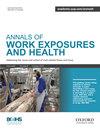236 Occupational exposure to microorganisms and endotoxin during treatment of offshore drilling waste
IF 1.8
4区 医学
Q3 PUBLIC, ENVIRONMENTAL & OCCUPATIONAL HEALTH
引用次数: 0
Abstract
Introduction The aim of this study was to describe the occupational exposure to microorganisms and endotoxin, for workers employed in the recycling of offshore drilling waste. A pilot study on two treatment plants, showed presence of human bacterial- and fungal pathogens in the drilling waste and showed a need for this larger study. Methodology The study included 7 different plants across Norway, thus encompassing most of the industry. 435 personal full-shift analyses, 26 bulk samples and 123 stationary short-time samples of microorganisms were collected. Viable bacterial and fungal species were identified with MALDI-TOF, and bacterial and fungal DNA with ddPCR. The biofilm formation potential was also measured using an Epoch microplate spectrophotometer. Results Even though mean exposure was low, some workers were exposed to high levels of endotoxin (207 EU/m3), bacteria (3.8x104 CFU/m3 and 9.8x104 DNA copies/m3) or fungi (1.4x107 CFU/m3 and 3600 DNA copies/m3). The drilling waste contained a high number of bacteria (102 to 1010 CFU of bacteria/mL) and pathogens in risk class 2 were found in all plants. The biofilm formation potential varied between the different plants. Conclusions Despite moderate exposure levels, certain work tasks, job titles, areas, and techniques, were associated with elevated levels of microorganisms and endotoxin. Human pathogens were present in the drilling waste, the workers can be exposed via the air and potentially via splashes.236 在近海钻井废物处理过程中的微生物和内毒素职业接触
引言 本研究旨在描述从事近海钻井废料回收工作的工人在工作中接触微生物和内毒素的情况。对两家处理厂进行的试点研究表明,钻井废料中存在人类细菌和真菌病原体,因此有必要进行这项更大规模的研究。研究方法 这项研究包括挪威各地的 7 家不同工厂,因此涵盖了大部分行业。共收集了 435 份个人全班分析、26 份散装样本和 123 份微生物固定短时样本。使用 MALDI-TOF 鉴定了可存活的细菌和真菌物种,使用 ddPCR 鉴定了细菌和真菌 DNA。还使用 Epoch 微孔板分光光度计测量了生物膜形成的可能性。结果 尽管平均接触量较低,但一些工人还是接触到了高浓度的内毒素(207 EU/m3)、细菌(3.8x104 CFU/m3和9.8x104 DNA拷贝/m3)或真菌(1.4x107 CFU/m3和3600 DNA拷贝/m3)。钻井废料中含有大量细菌(102 至 1010 CFU 细菌/毫升),在所有植物中都发现了风险等级为 2 的病原体。不同工厂形成生物膜的可能性各不相同。结论 尽管接触水平适中,但某些工作任务、职称、区域和技术与微生物和内毒素水平升高有关。人类病原体存在于钻井废料中,工人可能通过空气接触,也可能通过飞溅物接触。
本文章由计算机程序翻译,如有差异,请以英文原文为准。
求助全文
约1分钟内获得全文
求助全文
来源期刊

Annals Of Work Exposures and Health
Medicine-Public Health, Environmental and Occupational Health
CiteScore
4.60
自引率
19.20%
发文量
79
期刊介绍:
About the Journal
Annals of Work Exposures and Health is dedicated to presenting advances in exposure science supporting the recognition, quantification, and control of exposures at work, and epidemiological studies on their effects on human health and well-being. A key question we apply to submission is, "Is this paper going to help readers better understand, quantify, and control conditions at work that adversely or positively affect health and well-being?"
We are interested in high quality scientific research addressing:
the quantification of work exposures, including chemical, biological, physical, biomechanical, and psychosocial, and the elements of work organization giving rise to such exposures;
the relationship between these exposures and the acute and chronic health consequences for those exposed and their families and communities;
populations at special risk of work-related exposures including women, under-represented minorities, immigrants, and other vulnerable groups such as temporary, contingent and informal sector workers;
the effectiveness of interventions addressing exposure and risk including production technologies, work process engineering, and personal protective systems;
policies and management approaches to reduce risk and improve health and well-being among workers, their families or communities;
methodologies and mechanisms that underlie the quantification and/or control of exposure and risk.
There is heavy pressure on space in the journal, and the above interests mean that we do not usually publish papers that simply report local conditions without generalizable results. We are also unlikely to publish reports on human health and well-being without information on the work exposure characteristics giving rise to the effects. We particularly welcome contributions from scientists based in, or addressing conditions in, developing economies that fall within the above scope.
 求助内容:
求助内容: 应助结果提醒方式:
应助结果提醒方式:


